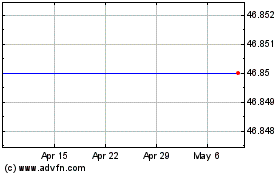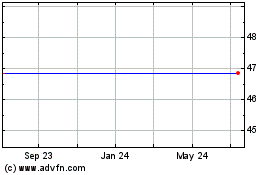CALGARY, Alberta—Energy companies aren't the only ones reeling
from the industry's bust.
Japanese auto maker Toyota Motor Corp.'s supply and trading arm,
Toyota Tsusho Corp., made an ill-timed bet on Canadian natural gas,
inking a $500 million deal with Canada's Encana Corp. in 2012 to
develop gas-rich lands in southern Alberta. Two years after the
market for such joint ventures collapsed, the deal has devolved
into a court battle over who owns the underlying assets.
Deals pairing an outside investor with an energy producer became
a popular way of financing new wells a few years ago. Several such
agreements have been struck in the U.S. and Canada, many with
foreign investors eager to tap into the unfolding shale boom.
With oil prices below $50 a barrel and natural gas hitting
17-year lows earlier this year, these revenue-sharing agreements
haven't turned out to be the bonanza expected by many producers and
investors.
The dispute between Toyota and its Canadian operating partner is
another in a string of disappointing investments by Asian investors
eager to establish a beachhead in North American energy by
targeting assets in Western Canada.
Some operators, such as Whiting Petroleum Corp., still embrace
this financing model, saying it allows them to continue drilling
more wells at current prices than they could otherwise afford. But
legal experts say their heyday has passed.
"Those went out of vogue with the collapse of oil and gas
prices," said Michael Darden, head of the oil and gas practice at
Latham & Watkins LLP in Houston. "We were doing them like crazy
and a lot of the money was from foreign investors," he said.
The deals are a way for energy producers to boost output, even
though they can reduce the return on their assets. Jim Volker,
Whiting's chief executive, told analysts on a July 28 conference
call that having an outside investor pay 65% of a well's cost in
return for 50% of its earnings is a good deal with profits capped
by prices below $60 a barrel.
The deals allow outside investors to invest directly in oil and
gas wells without the burden of operating them, and corporations
can use them to hedge against energy-price spikes that raise their
fuel costs. If commodity prices rise, these participation
agreements can pay off handsomely. But they come with a big
downside risk—unprofitable wells can be shut down, permanently
halting the profit-sharing and forcing the minority partner to
forgo its investment.
Toyota Tsusho and Encana hailed their joint venture as a model
marriage between Asian capital and North American energy
production. Under the deal, Toyota was to invest 600 million
Canadian dollars (US$462 million) in exchange for a 32.5% royalty
interest in production from half a million acres of gas-rich lands
in western Canada. For its part, Encana got funds to help cover the
cost of 4,000 existing wells and some 1,500 future drilling
locations.
Encana's joint venture with Toyota was the first of several
similar deals it struck with outside partners in 2012. The
Calgary-based company also received funds in return for a
percentage of production royalties from Mitsubishi Corp. of Japan,
U.S. steelmaker Nucor Corp. and Chinese state-controlled energy
giant PetroChina, each for different assets in Canada and the
U.S.
In late 2013, Nucor said it suspended the drilling program with
Encana in Colorado's Piceance Basin, citing low natural-gas
prices.
"We're not pursuing any joint ventures" now, Doug Suttles,
Encana's chief executive, said in an interview.
Toyota Tsusho, in which Toyota Motor owns about a one-third
stake directly and through another affiliate, has branched out in
recent years from its core automotive-parts and
vehicle-distribution business, but it is still a relative newcomer
to the energy industry. Its energy holdings account for just a
fraction of its overall profit and focus on coal-fired and
wind-generated electric power, according to its annual report.
That shows its only other investments in natural-gas production
beyond its Canadian business, known as Toyota Tsusho Wheatland
Inc., are minority interests in some Australian offshore
fields.
Most oil and gas operators only lease production rights and can
sell off part of the resulting revenue stream to outside investors.
What made the Toyota deal unique—and the subject of a lawsuit—is
that Encana had full title to own mineral rights from "fee simple"
Canadian government land grants dating to the 1880s.
Encana and Toyota Tsusho both declined to comment on the legal
wrangling. But they have staked out opposing positions in public
documents filed with the province of Alberta's superior court.
Toyota says its contract effectively makes it a co-owner of
underlying mineral rights to more than 450,000 acres in southern
Alberta and hundreds of wells drilled on those lands, and protects
its investment despite well shutdowns due to low prices.
Encana contests that view, arguing in court filings that it
never agreed to share ownership to the underlying mineral rights,
only a portion of the royalties earned from them. It wants the case
dismissed and the court in April referred most of the claims made
against it to arbitration under international law.
The Tokyo-based company also contends Encana didn't have the
right to unilaterally transfer those assets to a former
subsidiary.
After its deal with Toyota Tsusho, Encana carved out its royalty
unit into a new company called PrairieSky Royalty Ltd., which took
over ownership of the disputed mineral rights. To raise cash,
Encana split off that company in a 2014 initial public offering.
Toyota Tsusho alleges Encana engaged in a conspiracy to deprive it
of funds raised from the IPO and subsequent sale of a retained
stake.
"The fee title transaction, which lay at the heart of the
PrairieSky IPO and created value for both Encana and PrairieSky,
was a material breach of the Toyota agreements," according to a
statement of claim filed by Toyota Tsusho Wheatland with the Court
of Queen's Bench of Alberta.
Representatives for PrairieSky didn't respond to a request for
comment.
Write to Chester Dawson at chester.dawson@wsj.com
(END) Dow Jones Newswires
September 04, 2016 22:15 ET (02:15 GMT)
Copyright (c) 2016 Dow Jones & Company, Inc.
Petrochina (NYSE:PTR)
Historical Stock Chart
From Mar 2024 to Apr 2024

Petrochina (NYSE:PTR)
Historical Stock Chart
From Apr 2023 to Apr 2024
